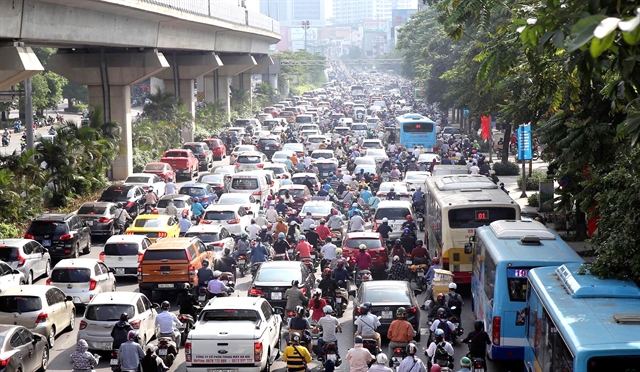 Society
Society

 |
| Congestion on Nguyễn Trãi Street in Thanh Xuân District, Hà Nội.— VNA/VNS Photo Danh Lam |
HÀ NỘI — Hà Nội will limit residential and high-rise buildings that put pressure on traffic infrastructure in the inner districts, in an effort to curb congestion in the capital.
The move comes after Dương Đức Tuấn, deputy chairman of the People’s Committee of Hà Nội, signed a plan on ensuring traffic order and safety, as well as combating congestion, in the 2022-25 period in the city, under the Government's Resolution No. 48/2022.
The resolution has three goals; to reduce traffic accidents by 5-10 per cent, to increase the rate of public transport usage to 30-35 per cent, and reduce traffic congestion in 7-10 parts of the city.
To reach these goals, the city will strictly manage the process of planning, ensuring the new construction or embellishment of industrial parks, urban areas, commercial centres, schools and hospitals is in line with the capacity of traffic and public transport infrastructure.
The committee has assigned the city’s Planning and Architecture Department to coordinate with relevant agencies in managing urban planning and construction.
The department has been told to only approve projects consistent with the planning orientation and current regulations, that meet the requirements for parking, traffic infrastructure and traffic connections connected with the main axes in urban areas, without increasing pressure on traffic infrastructure and causing traffic jams.
The city will also deploy investment projects on traffic infrastructure and accelerate the development of public transport systems in urban areas to limit personal vehicles in the future.
Preventing arbitrary planning adjustment
Đào Ngọc Nghiêm, Deputy Chairman of Việt Nam Urban Development and Planning Association, told Pháp Luật TP.HCM (HCM City Law) newspaper that this is not new content, as previously the city had already passed a decision on the planning of high-rise buildings in the inner city, which oriented all criteria on population and traffic.
However, there is a difference between planning and implementation, he said.
The reality shows that many projects are continuously adjusted to the planning and the completed projects increase the population target, causing pressure on transport infrastructure, he said.
Therefore, it is necessary to prevent arbitrary adjustment of planning to shorten the gap between planning and planning implementation, he said.
To do this, first of all, a plan must be developed with a long-term vision.
Traffic expert Đỗ Cao Phan said the city should propose the Government to speed up the relocation of ministries, branches, medical facilities, educational facilities and production facilities out of the city’s inner districts.
Additionally, it has to give the priority to using the land fund to develop transport infrastructure or serve public purposes.
The relocation plan was issued many years ago, but has yet to be implemented, he said.
“If we don't drastically accomplish the plan, traffic jams will last longer,” he added.
$1-billion damage
Data from the Transport Development and Strategy Institute under the Ministry of Transport show that traffic jams cost US$1 billion each year in Hà Nội.
In terms of society, the health of city dwellers is also affected as the air pollution index is more than five times higher than the regulations.
The main cause of congestion is the population density is unevenly distributed and concentrated too much in the inner city; vehicle growth rate compared to infrastructure growth rate is inadequate; public passenger transport remains underdeveloped; and the ratio of land for traffic only reaches 8.65 per cent of the total land area for urban areas while the standard is between 16 and 26 per cent.
Statistics from the transport department revealed that a series of urban roads in the city are currently overloaded.
For example, the number of vehicles travelling from Lê Văn Lương Street to Láng Street is often 3.9 times higher than recommended, while the number travelling from Tố Hữu Street to Lê Văn Lương Street is often 1.7 times higher. The number of vehicles travelling from Nguyễn Trãi Street towards the city's centre is often more than six times higher than recommended.
Trần Hữu Bảo, deputy director of the transport department, said traffic planning needs to be done first, then urban planning, to limit congestion.
However, in Hà Nội, urban planning is not matched with traffic planning so local roads have to bear too many vehicles, leading to traffic congestion, he said.
According to the department, there are 33 traffic intersections in the city that are often severely congested during rush hour. — VNS




